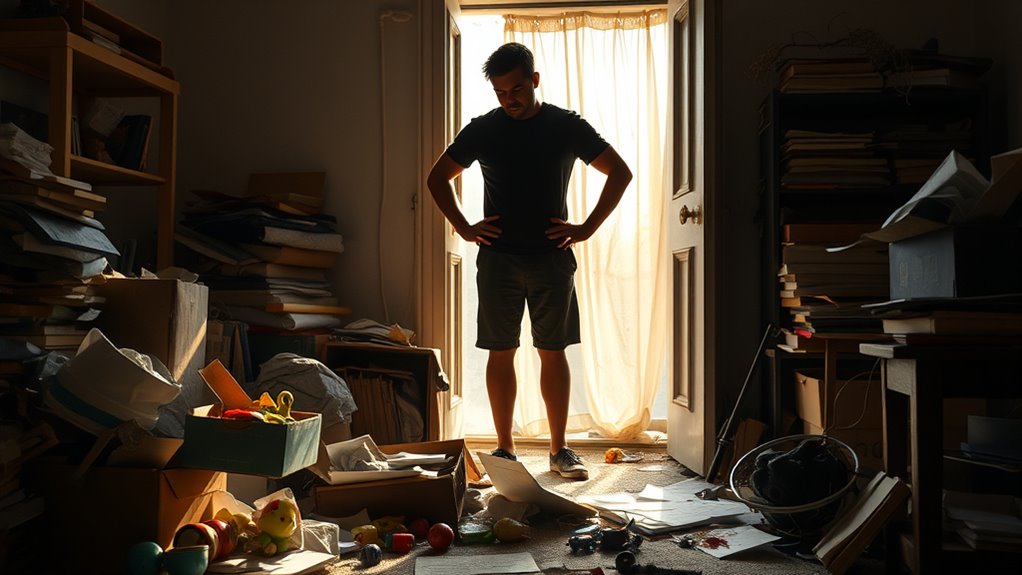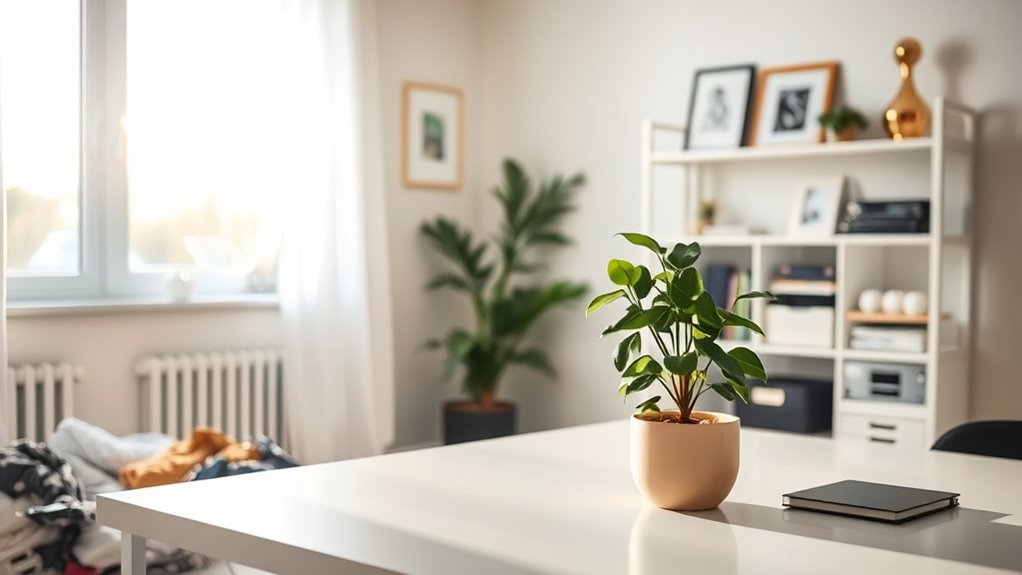Your decluttering efforts probably fail because you mistake organization for true reduction. Simply rearranging items or buying more storage won't help; it just postpones the clutter problem. To succeed, you need a structured plan with specific goals and timelines. Emotional attachments can also hold you back, making it tough to let go. By understanding these challenges and implementing effective strategies, you can conquer the chaos and reclaim your space. More insights await to guide your journey.
Key Takeaways
- Relying solely on storage solutions creates a temporary fix; true decluttering requires letting go of unnecessary items.
- Emotional attachments can create mental blocks; start with less sentimental items to ease the decluttering process.
- Lack of a structured plan leads to overwhelm; create a clear strategy with specific goals and timelines for success.
- Focusing on maintaining organization is crucial; regular maintenance sessions help prevent clutter from re-accumulating.
- Acknowledging feelings without judgment allows for better decision-making and reduces guilt over letting go of items.
Common Misconceptions About Decluttering

Have you ever thought that buying more storage containers would solve your clutter problems? Many people fall for that misconception, thinking it's a quick fix for their clutter.
Buying more storage containers won't solve your clutter problems; it's merely a misconception that offers a temporary fix.
But true decluttering isn't just about reorganizing; it's about letting go of unnecessary items. A professional organizer will tell you that understanding which possessions to keep versus discard is essential for long-term organization.
It's easy to confuse tidying up with real decluttering, but the emotional satisfaction comes from reducing your belongings, not just rearranging them.
Plus, fearing minimalism can hinder your progress—letting go of sentimental items doesn't mean you have to discard everything.
To genuinely declutter your home, focus on removing what you don't need instead of just storing it away. Additionally, incorporating seasonal arrangements can help you create a more inviting space, making it easier to let go of excess items.
The Importance of a Structured Plan

While decluttering can feel overwhelming, having a structured plan can make all the difference. By creating a decluttering action plan, you break tasks down into manageable steps, making it easier to tackle clutter systematically.
Setting clear goals within your plan enhances focus and keeps you motivated throughout the process. Writing down your plan increases accountability, allowing you to track your progress and adjust as needed.
Scheduling dedicated decluttering sessions as appointments emphasizes the importance of consistency in achieving long-term results. Regularly updating and reviewing your structured plan helps you stay on track and prevents the re-accumulation of clutter.
Incorporating best lifestyle planners into your strategy can provide added support for effective organization. With a solid strategy in place, you're more likely to achieve the organized space you desire.
Emotional Challenges in the Decluttering Process

Even with a structured plan, emotional challenges can complicate the decluttering process. Your emotional attachment to items can create mental blocks, making it tough to let go.
Sentimental items, like family heirlooms, often evoke strong feelings, causing indecision. You might even feel guilty about discarding belongings that hold memories.
To overcome these emotional challenges and build confidence, consider these steps:
- Start with less emotionally charged items to ease into the process.
- Acknowledge your feelings without judgment.
- Remember the "Just in Case" mentality can hinder progress; focus on what you truly need.
- Set clear intentions for keeping items, prioritizing those that genuinely add value to your life. Additionally, it may help to recognize that letting go of items can lead to greater feelings of freedom, allowing you to make space for new experiences and opportunities.
Strategies for Sustainable Decluttering

To achieve lasting decluttering success, it's essential to implement strategies that foster sustainability in your organization efforts.
Start by creating a clear decluttering plan with specific goals and timelines. Focus on one area at a time and break it down into manageable sections, so you don't feel overwhelmed.
Create a decluttering plan with clear goals, tackling one area at a time to avoid feeling overwhelmed.
When sorting through a category of items, ask yourself what you truly need and let go of things that no longer serve you. Designate a space for the items you keep, ensuring each has an accessible spot.
Incorporate regular maintenance sessions, like monthly check-ins, to prevent clutter from building up again. Don't hesitate to seek support from friends or family to keep you motivated and make the process enjoyable. Additionally, practicing mindful decluttering strategies can help you refine your approach and maintain a clutter-free environment.
The Long-term Benefits of Successful Decluttering

Successful decluttering doesn't just create an organized space; it brings a wealth of long-term benefits that can transform your life.
Embracing successful decluttering can greatly improve your well-being and efficiency. Here are some key benefits:
- Reduce stress: An organized environment leads to improved mental clarity and emotional stability.
- Enhance productivity: A clutter-free workspace can boost your focus and productivity by up to 30%.
- Better relationships: A tidy home fosters social interactions, minimizing feelings of embarrassment.
- Time and money savings: Regular decluttering habits help you find items easily and avoid unnecessary purchases.
Frequently Asked Questions
What Is the 50% Rule in Decluttering?
The 50% Rule in decluttering suggests you aim to remove at least half of your belongings in a specific category.
This approach helps you make clearer decisions about what to keep, focusing on quality over quantity. By targeting that 50% mark, you simplify the process and reduce feelings of overwhelm.
It encourages a healthier relationship with your possessions, making your space more functional and organized, which ultimately supports long-term decluttering success.
Why Am I Having Such a Hard Time Decluttering?
Decluttering can feel like a stormy sea, tossing you around with emotional attachments and overwhelming tasks.
You're struggling because it's tough to let go of sentimental items that pull at your heartstrings. When you try to tackle everything at once, it's easy to freeze in place.
Inconsistent efforts might leave you feeling stuck, and misplacing decluttering for mere reorganizing doesn't solve the root of the problem.
It's time to sail with a clear plan and steady commitment.
What Is the 80/20 Decluttering Rule?
The 80/20 decluttering rule means that roughly 80% of your clutter comes from just 20% of your belongings.
By identifying those key items that create most of the mess, you can focus your efforts where they'll make the biggest difference.
This approach helps you prioritize decluttering the spaces and items you use most, reducing overwhelm and decision fatigue, while creating a more organized and enjoyable living environment.
What Is the 12-12-12 Rule for Decluttering?
Think of decluttering like a game of Tetris—fitting pieces into place to create a clear space.
The 12-12-12 rule makes this easy. You find 12 items to throw away, 12 to donate, and 12 to return to their rightful spots. This structured approach breaks the overwhelming task into manageable chunks.
By consistently applying this method, you'll feel accomplished and maintain an organized environment without feeling buried under clutter.
Give it a try!
Conclusion
So, if you thought tossing a few items would magically transform your life, think again! Decluttering's not just a weekend warrior's game; it's a marathon of emotional hurdles and strategic planning. But hey, who needs a clear space when you can keep that 2003 pizza box for "sentimental reasons"? Embrace the chaos, or better yet, grab a plan and tackle it like the champion you are. Because really, wouldn't you rather find your couch than your childhood dreams?









